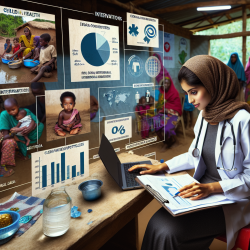Introduction
Diarrhea remains a major public health challenge in sub-Saharan Africa, particularly affecting children under the age of five. A recent study titled Diarrhea as a Disease of Poverty Among Under-Five Children in Sub-Saharan Africa: A Cross-Sectional Study provides valuable insights into the prevalence and sociodemographic factors associated with diarrhea in this region. Understanding these findings is crucial for practitioners aiming to improve health outcomes for children through evidence-based interventions.
Key Findings from the Research
The study analyzed data from 36 countries, revealing an overall diarrhea prevalence of 18.44% among children under five. Notably, boys exhibited a higher prevalence (19.12%) compared to girls (17.75%). The research identified several key factors influencing diarrhea prevalence:
- Wealth Gradient: Children from wealthier households had a lower risk of diarrhea, with risk ratios decreasing progressively with higher wealth quintiles.
- Rural vs. Urban Residency: Rural residency was associated with a slightly lower risk of diarrhea compared to urban areas.
- Access to WASH Facilities: Lack of access to improved water and sanitation facilities significantly increased the risk of diarrhea.
- Maternal Education: Higher maternal education levels were linked to reduced diarrhea risk, highlighting the importance of maternal health literacy.
Implications for Practice
Practitioners can leverage these findings to enhance their interventions and strategies. Here are some actionable steps:
- Targeted Interventions: Focus on improving access to clean water and sanitation facilities, particularly in impoverished and rural areas.
- Maternal Education Programs: Develop community education programs to enhance maternal health literacy, emphasizing hygiene practices and child care.
- Policy Advocacy: Advocate for policies that address the wealth disparities affecting child health, ensuring equitable access to healthcare resources.
Encouraging Further Research
While the study provides significant insights, further research is needed to explore the underlying mechanisms of sex differences in diarrhea prevalence and the impact of birth order. Practitioners are encouraged to engage in collaborative research efforts to deepen the understanding of these factors and develop more effective interventions.
Conclusion
The study underscores the critical link between poverty and child health outcomes in sub-Saharan Africa. By implementing data-driven strategies and fostering research collaborations, practitioners can significantly reduce the burden of diarrhea and improve health outcomes for children. For a deeper dive into the research, read the original research paper.










